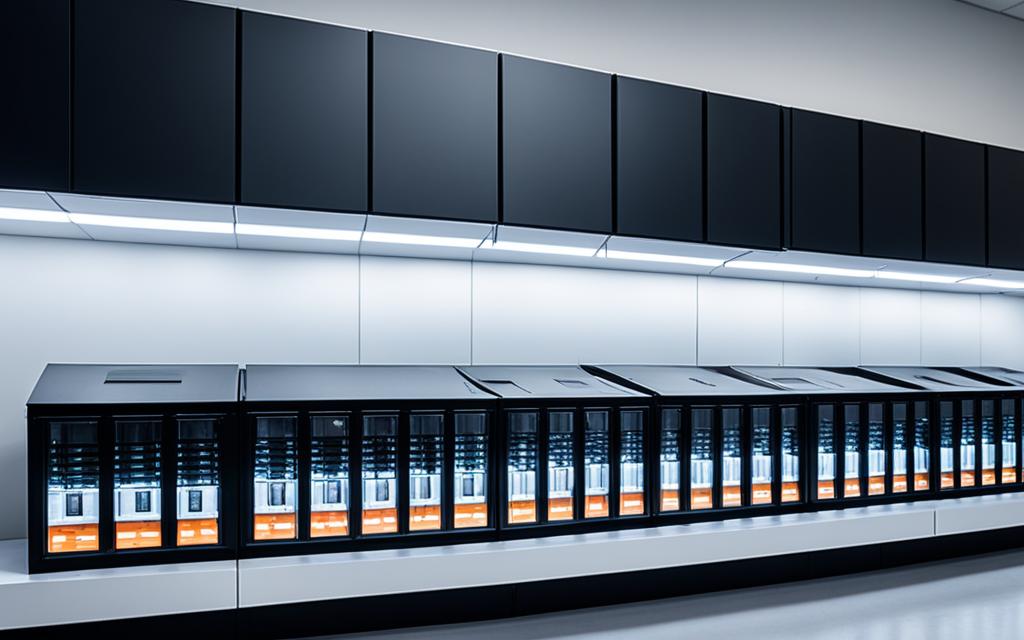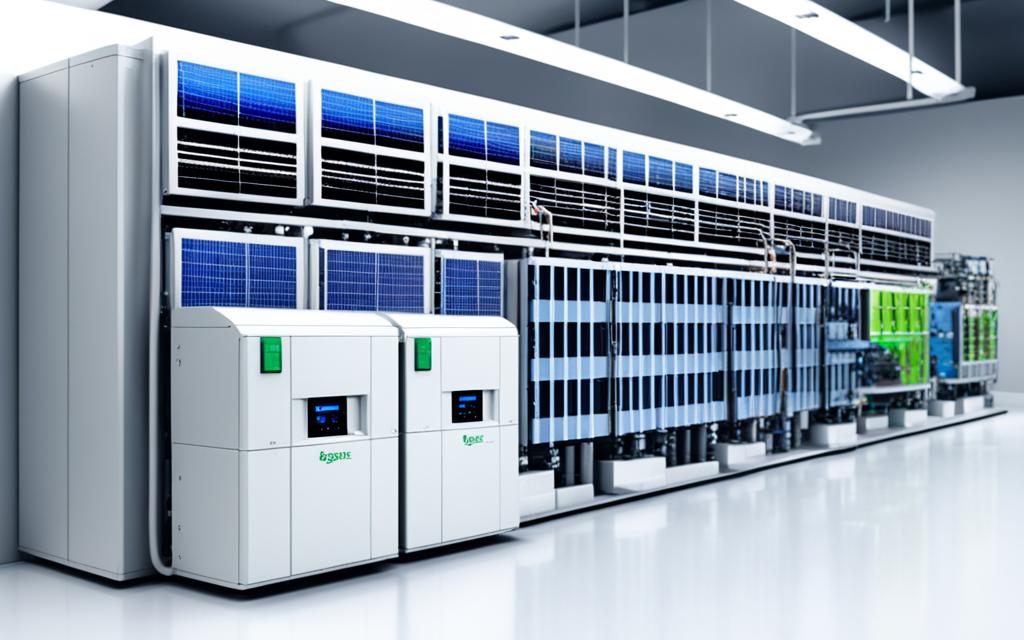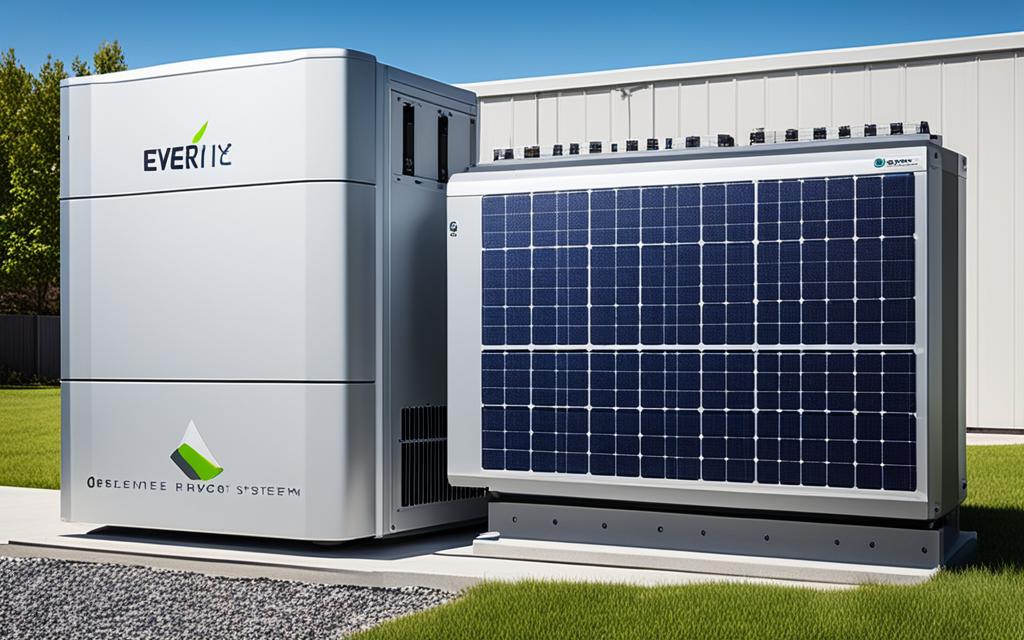Specifications For Energy Storage Systems

Energy storage systems play a vital role in today’s energy landscape, offering the ability to store and manage power efficiently.
To make informed decisions about energy storage, it is important to understand the specifications that determine the performance and capabilities of these systems.
From battery modules and cabinets to inverters and coupling methods, each specification contributes to the overall efficiency and reliability of energy storage systems.
As power management becomes increasingly crucial, optimizing energy storage systems requires a deep understanding of their specifications.
Key Takeaways:
- Energy storage systems are essential for efficient power management.
- Understanding the specifications of battery modules, cabinets, inverters, and coupling methods is crucial for maximizing system performance.
- Power rating and battery capacity are key specifications that define the capabilities of energy storage systems.
- Maximum continuous power output and peak output are important specifications for ensuring reliability in different applications.
- By considering and optimizing these specifications, users can enhance the efficiency and reliability of their energy storage systems.
Lithium-Ion Batteries In Energy Storage Systems
Lithium-ion batteries are highly sought after in the field of energy storage systems due to their exceptional characteristics and performance.
These batteries offer a multitude of advantages, making them a preferred choice for a wide range of applications.
One of the key attributes of lithium-ion batteries is their high energy density.
This allows them to store a significant amount of energy in a compact and lightweight package, making them ideal for portable devices as well as grid-connected systems.
Additionally, lithium-ion batteries have a long cycle life, enabling them to be charged and discharged numerous times without significant degradation in performance.
This longevity ensures the reliability and durability of the energy storage system, making it a cost-effective solution in the long run.
Furthermore, lithium-ion batteries exhibit low self-discharge rates, meaning they retain energy even when not in use.
This feature reduces the risk of energy loss over time, improving the overall efficiency of the energy storage system.
These remarkable characteristics have made lithium-ion batteries a popular choice in various industries, including consumer electronics, electric vehicles, and renewable energy systems.
Their reliability, efficiency, and high energy density make them well-suited for meeting the demands of energy storage systems.
Battery Modules For Streamlined Installation And Maintenance
Battery modules are crucial components of energy storage systems, providing a streamlined approach to installation and maintenance.
These self-contained units consist of multiple battery cells that work together to store and release energy efficiently.
One of the primary advantages of battery modules is their ability to simplify the installation process.
Rather than managing individual batteries separately, battery modules allow for a more organized and efficient setup.
This reduces complexity and minimizes the time and effort required for installation, ensuring a smoother transition into operation.
Furthermore, battery modules offer increased scalability and flexibility in energy storage systems.
These modules can be seamlessly combined to form larger battery packs, allowing for easy expansion as energy demands increase.
Whether it’s for residential, commercial, or industrial applications, the scalability of battery modules ensures that energy storage systems can adapt to evolving needs.
Battery modules are widely utilized in renewable energy applications and electric vehicles.
The modular design enables easier integration into solar power systems, wind farms, and other forms of renewable energy infrastructure.
Additionally, electric vehicle manufacturers use battery modules to optimize their vehicles’ performance and range, providing efficient and reliable power on the go.
“Battery modules streamline the installation and maintenance of energy storage systems while offering scalability and flexibility. Their modular design simplifies installation, reduces complexity, and allows for easy expansion as energy demands increase.”
With their streamlined installation and maintenance processes, along with their scalability and flexibility, battery modules play a vital role in enhancing the efficiency and effectiveness of energy storage systems.
By simplifying the setup and allowing for expansion, battery modules contribute to the seamless integration of renewable energy sources and the widespread adoption of electric vehicles.
Battery Cabinets For Protection And Organization
Battery cabinets are an essential component in energy storage systems.
They provide a secure and organized environment for housing multiple battery modules.
These cabinets play a crucial role in ensuring the efficient operation and longevity of the batteries.
One of the primary functions of battery cabinets is to protect the batteries from external factors that can compromise their performance and safety.
These cabinets are equipped with robust safety features, such as fire suppression systems and cooling mechanisms, that help maintain optimal temperature and prevent potential hazards.
“Battery cabinets provide a secure and controlled environment for the batteries, minimizing the risk of accidents and optimizing the overall safety of the energy storage system.”
In addition to safety, battery cabinets also optimize space utilization within the energy storage system.
They are designed to accommodate the battery modules efficiently, minimizing wasted space and allowing for easy access during installation and maintenance processes.
This efficient organization of the battery modules simplifies management and contributes to the overall scalability of the system.

The image above showcases a state-of-the-art battery cabinet, providing a visual representation of the protective enclosure used in energy storage systems.
Overall, battery cabinets are essential for maintaining the integrity and performance of energy storage systems.
By housing and protecting the battery modules, they ensure safety, organization, and optimized space utilization – key factors for reliable and efficient energy storage.
Inverters For Efficient Power Conversion
Inverters are essential components in a battery storage system that enable efficient power conversion.
Their primary function is to convert direct current (DC) electricity, which is stored in the batteries, into alternating current (AC) electricity.
This conversion is crucial for maximizing the utilization of the energy stored in the batteries and facilitating seamless integration with electrical appliances and the power grid.
The role of inverters goes beyond simple power conversion.
They act as a bridge between the battery system and the devices that rely on the stored energy.
By seamlessly converting and delivering AC electricity, inverters enhance the efficiency and convenience of battery storage systems, allowing for a smooth and reliable power supply.
One key advantage of using inverters in a battery storage system is their ability to integrate with the electrical grid.
This allows users to harness renewable energy sources, such as solar or wind, and store the excess energy generated for later use.
Inverters facilitate this process by converting the DC electricity generated by the renewable source into AC electricity that can be seamlessly connected to the grid or used to power electrical loads directly.
“Inverters play a crucial role in maximizing the efficiency of battery storage systems. They not only convert the stored energy but also enable seamless integration with the grid, making it easier to harness renewable energy.”
Furthermore, inverters ensure the compatibility and synchronization between the battery storage system and the power grid.
They help regulate the frequency, voltage, and power factor of the AC electricity produced, ensuring that it meets the quality standards required by the grid.
This synchronization is essential for the efficient operation of the system and for facilitating the export of excess energy back to the grid.
With advancements in technology, modern inverters offer additional features such as grid support, islanding protection, and advanced monitoring capabilities.
These features enhance the overall performance and reliability of the battery storage system, allowing for optimal utilization of the stored energy.
Investing in high-quality inverters is crucial for the successful implementation of a battery storage system.
Inverters with superior power conversion efficiency not only maximize the energy utilization but also reduce energy losses, resulting in higher overall system performance.
Benefits Of Inverters In Battery Storage Systems
- Efficient conversion of DC to AC electricity.
- Seamless integration with electrical appliances and the power grid.
- Facilitate the use of renewable energy sources.
- Enable synchronization and compatibility with the power grid.
- Additional features for improved performance and reliability.
By understanding the role of inverters and their benefits in battery storage systems, users can make informed decisions about selecting the right inverters for their specific application.
Choosing inverters that are compatible with the battery storage system and meet the required specifications is essential for achieving enhanced power conversion and efficient power management.
Switch manufacturers should note these specifications and innovate and develop energy storage systems with enhanced efficiency and reliability.
AC-Coupled And DC-Coupled Systems For Integration
When it comes to integrating battery storage systems into electrical setups, there are two popular approaches: AC-coupled systems and DC-coupled systems.
Each method offers unique benefits and is suited to different requirements. Let’s explore these approaches in more detail.
AC-Coupled Systems
AC-coupled systems are designed to connect to the AC side of an electrical system.
This makes them ideal for retrofitting into existing setups, as they can easily integrate with the AC wiring already in place.
AC-coupled systems offer versatility and can be used with a wide range of energy sources, making them a flexible choice for both residential and commercial applications.
With an AC-coupled system, the battery storage solution can be connected to the existing electrical infrastructure, allowing for seamless integration.
This approach simplifies the installation process and provides the convenience of accessing stored energy whenever it’s needed. AC-coupled systems are compatible with various energy sources, including solar panels and the power grid, enabling efficient energy management.
DC-Coupled Systems
DC-coupled systems take a different approach by integrating with the DC side of the electrical setup.
This method is especially advantageous for new solar installations, maximizing the efficiency of the system.
By directly coupling the battery storage to the solar panels, DC-coupled systems reduce energy conversion losses, resulting in higher overall efficiency.
In a DC-coupled system, energy from the solar panels is sent directly to the battery storage, allowing for efficient charging and utilization of the stored energy.
This approach is particularly beneficial when the primary goal is to optimize the performance of the solar installation.
DC-coupled systems provide enhanced control over energy flow, enabling users to maximize solar power generation.

AC-coupled and DC-coupled systems offer tailored solutions for integrating battery storage systems into electrical setups.
AC-coupled systems excel in their ease of installation and compatibility with existing infrastructure, making them a popular choice for retrofitting.
On the other hand, DC-coupled systems maximize the efficiency of new solar installations, ensuring optimal utilization of solar power.
The decision between the two depends on the specific requirements of the electrical setup and the desired outcomes.
By choosing the right coupling method, users can integrate battery storage systems seamlessly into their electrical setups, optimizing energy management and enhancing overall efficiency.
Power Rating And Battery Capacity For Performance
The power rating and battery capacity are crucial specifications that directly impact the performance and capabilities of a battery storage system.
These specifications play a vital role in determining the system’s overall suitability for specific applications and optimizing energy storage operations.
The power rating of a battery storage system indicates its ability to deliver or receive power at any given moment.
It represents the system’s power capacity and is measured in kilowatts (kW) or megawatts (MW). A higher power rating allows the system to handle larger electrical loads, making it suitable for applications with higher power demands.
On the other hand, battery capacity represents the amount of energy the system can store over time, measured in kilowatt-hours (kWh) or megawatt-hours (MWh).
Battery capacity determines the system’s energy storage capability and influences its runtime or duration of operation.
A higher battery capacity enables the system to store more energy, extending the duration of power supply during times of high demand or when renewable energy sources are not readily available.
Optimizing the power rating and battery capacity of a battery storage system ensures efficient performance and reliable operation in a variety of applications.
By carefully assessing the power requirements and energy storage needs of a specific application, users can select a system with the appropriate power rating and battery capacity, effectively meeting their performance goals and maximizing the system’s potential.
Maximum Continuous Power Output And Peak Output
The maximum continuous power output specification is a critical factor to consider when evaluating the performance of a battery storage system.
It refers to the sustained power capacity that the system can provide over an extended period.
This specification ensures a consistent and uninterrupted power supply for applications that require high reliability and continuous operation.
On the other hand, peak output represents the maximum power that a battery storage system can deliver for shorter durations.
It refers to the system’s ability to handle intermittent spikes in power demand effectively.
Whether it’s powering up a heavy-duty electrical appliance or meeting a sudden surge in energy requirements, the peak output capacity plays a crucial role in determining the system’s performance under high-demand scenarios.
Both the maximum continuous power output and peak output are essential specifications to consider when selecting a battery storage system.
They help assess the system’s suitability for specific applications and ensure it can deliver the required power levels consistently and efficiently.

Understanding the specifications of energy storage systems is essential for maximizing their efficiency and reliability.
Battery modules, cabinets, inverters, and coupling methods are all vital components that contribute to the performance of these systems.
Power rating, battery capacity, maximum continuous power output, and peak output are key specifications that determine the capabilities and suitability of an energy storage system for specific applications.
By carefully considering and optimizing these specifications, users can effectively harness energy and enhance power management in various settings.
Whether it’s in renewable energy applications, electric vehicles, or grid-connected systems, having a thorough understanding of energy storage system specifications enables users to make informed decisions that align with their energy needs and goals.
By continuously improving the specifications of battery modules, cabinets, inverters, and coupling methods, manufacturers can contribute to the advancement of energy storage technology, making it more accessible and beneficial for a wide range of industries and consumers.
